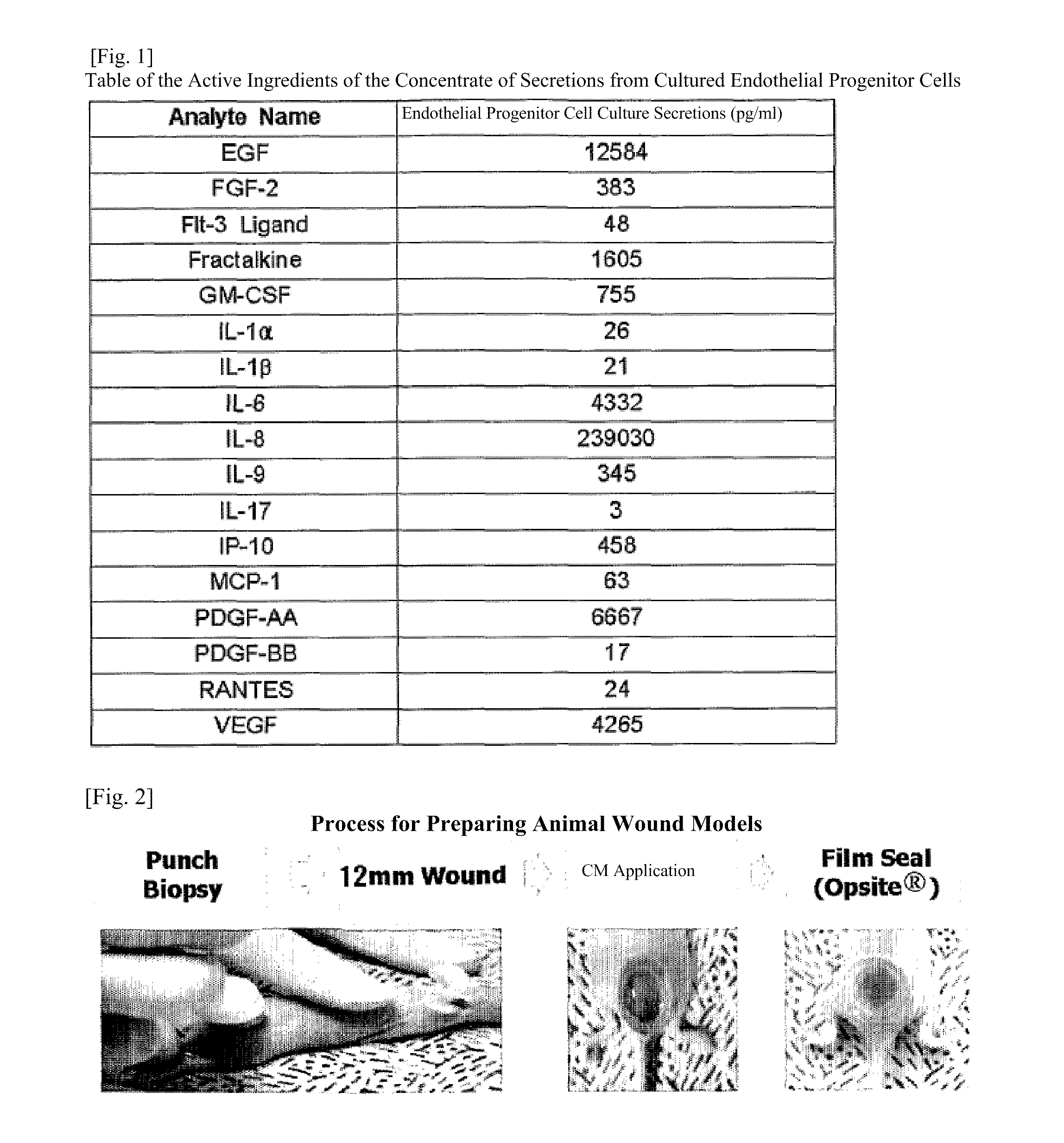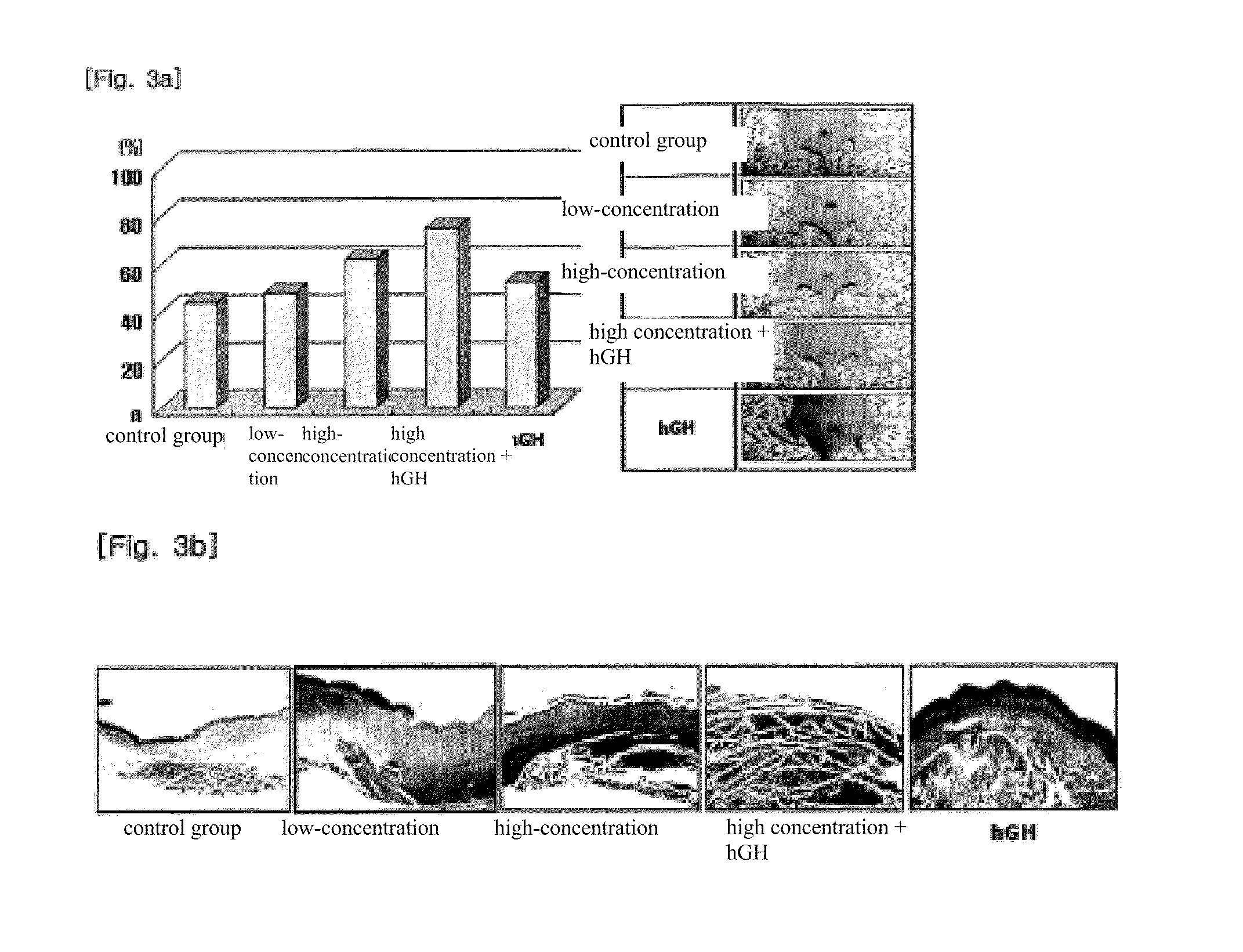Composition for skin regeneration, containing a secretion in the culture of an embryonic stem cell-derived endothelial progenitor cell or fractions thereof, and use thereof
a technology of endothelial progenitor cells and skin regeneration, which is applied in the direction of drug compositions, dermatological disorders, peptide/protein ingredients, etc., can solve the problems of increasing the risk of infection, replacing gauze will again irritate the wound site, and the effect of reducing the number of cells
- Summary
- Abstract
- Description
- Claims
- Application Information
AI Technical Summary
Benefits of technology
Problems solved by technology
Method used
Image
Examples
embodiment 1
[0044](1) Acquisition and Concentration of Human Embryonic Stem-Cell Derived Endothelial Progenitor Cell Culture Secretions
[0045]Human embryonic stem-cell derived endothelial progenitor cells were cultured in the culture medium EGM-2 / MV (Cambrex) on a culture dish coated with collagen; once the cells were distributed in the culture dish at a concentration of about 70% to 80%, the concentrate of secretions from the human embryonic stem-cell derived endothelial progenitor cells culture was obtained through a 48-hour culturing. The resulting culture secretions were concentrated 50 times using a TFF membrane concentration system in order to obtain the highly-concentrated culture secretion concentrate.
[0046](2) Preparing Animal Wound Models and Animal Burn Wound Models
[0047]FIG. 2 is a diagram with photographs showing the process for preparing and using the animal wound models for verifying efficacy in treating wounds.
[0048]To prepare the animal wound models for verifying efficacy in tre...
experimental example 1
[0055]A multiplex cytokine array was used on the concentrate of secretions from a human embryonic stem-cell derived endothelial progenitor cell culture obtained after culturing under the conditions set forth in (1) of Embodiment 1 in order to analyze the active ingredients in the resulting highly-concentrated concentrate (50 times).
[0056]FIG. 1 is a table showing an analysis of the components and amount of active ingredients in the concentrate of secretions from the human embryonic stem-cell derived endothelial progenitor cell culture of the present invention.
[0057]As shown in FIG. 1, the concentrate of secretions from the human embryonic stem-cell derived endothelial progenitor cell culture, concentrated 50 times, was found to contain large amounts of active ingredients that promote angiogenesis and wound healing, such as EGF, FGF-2, Fractalkine, GM-CSF, IL-6, IL-8, IL-9, IP-10, MCP-1, PDGF-AA, PDGF-BB, and VEGF.
[0058]The above results show that the concentrate of secretions from a...
experimental example 2
[0059]After the method set forth in (2) of Embodiment 1 was used to prepare animal wound models, the concentrate of secretions from a human embryonic stem-cell derived endothelial progenitor cell culture and the other comparison groups were applied inside the dorsal silicone ring (see FIG. 2).
PUM
| Property | Measurement | Unit |
|---|---|---|
| Density | aaaaa | aaaaa |
| Density | aaaaa | aaaaa |
| Density | aaaaa | aaaaa |
Abstract
Description
Claims
Application Information
 Login to View More
Login to View More - R&D
- Intellectual Property
- Life Sciences
- Materials
- Tech Scout
- Unparalleled Data Quality
- Higher Quality Content
- 60% Fewer Hallucinations
Browse by: Latest US Patents, China's latest patents, Technical Efficacy Thesaurus, Application Domain, Technology Topic, Popular Technical Reports.
© 2025 PatSnap. All rights reserved.Legal|Privacy policy|Modern Slavery Act Transparency Statement|Sitemap|About US| Contact US: help@patsnap.com



